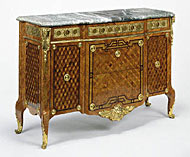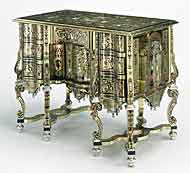N the Painting the Blue Room the Artist Uses Three Patterns That
This page provides definitions and examples of the elements of art that are used by artists working in various media. The elements of art are components or parts of a work of art that can be isolated and defined. They are the building blocks used to create a work of art.
Students who can identify the elements and evaluate their role in the composition of a work of art will be better able to understand an artist's choices. They will be equipped to address whether a work of art is successful, and why.
The arrangement of elements in a work of art. All works of art have an order determined by the artist. Composition creates a hierarchy within the work, which tells the viewer the relative importance of the imagery and elements included.
Symmetrical compositions convey a sense of stability. In this example, a single large figure in the center is flanked by a smaller figure on either side. The shape of the artwork itself is also symmetrical—a vertical line bisecting the image would create two equal halves that are mirror images of one another.
Asymmetrical compositions often convey a sense of movement since the elements of the composition are unbalanced. In this example, the artist used organic forms to create a composition that mimics the movement of vines growing in an unordered fashion around the clock face.
Line
A line is an identifiable path created by a point moving in space. It is one-dimensional and can vary in width, direction, and length. Lines often define the edges of a form. Lines can be horizontal, vertical, or diagonal, straight or curved, thick or thin. They lead your eye around the composition and can communicate information through their character and direction.
Examples:
Horizontal lines suggest a feeling of rest or repose because objects parallel to the earth are at rest. In this landscape, horizontal lines also help give a sense of space. The lines delineate sections of the landscape, which recede into space. They also imply continuation of the landscape beyond the picture plane to the left and right.
Vertical lines often communicate a sense of height because they are perpendicular to the earth, extending upwards toward the sky. In this church interior, vertical lines suggest spirituality, rising beyond human reach toward the heavens.
Horizontal and vertical lines used in combination communicate stability and solidity. Rectilinear forms with 90-degree angles are structurally stable. This stability suggests permanence and reliability.
Diagonal lines convey a feeling of movement. Objects in a diagonal position are unstable. Because they are neither vertical nor horizontal, they are either about to fall or are already in motion. The angles of the ship and the rocks on the shore convey a feeling of movement or speed in this stormy harbor scene.
In a two-dimensional composition, diagonal lines can also indicate depth through perspective. These diagonal lines pull the viewer visually into the image. For example, in this photograph the diagonal lines lead the eye into the space to the point where the lines converge.
The curve of a line can convey energy. Soft, shallow curves recall the curves of the human body and often have a pleasing, sensual quality and a softening effect on the composition. The edge of the pool in this photograph gently leads the eye to the sculptures on the horizon.
Sharply curved or twisted lines can convey turmoil, chaos, and even violence. In this sculpture, the lines of the contorting bodies and the serpent help convey the intensity of the struggle against the snake's stranglehold.
When repeated, lines can create a pattern. In this example, the artist repeated different kinds of lines across the composition to create various patterns. Patterned lines also give the image rhythm.
Shape and form
Shape and form define objects in space. Shapes have two dimensions—height and width—and are usually defined by lines. Forms exist in three dimensions, with height, width, and depth.
Examples:
Shape has only height and width. Shape is usually, though not always, defined by line, which can provide its contour. In this image, rectangles and ovals dominate the composition. They describe the architectural details for an illusionist ceiling fresco.
Form has depth as well as width and height. Three-dimensional form is the basis of sculpture, furniture, and decorative arts. Three-dimensional forms can be seen from more than one side, such as this sculpture of a rearing horse.
| |  |
Geometric shapes and forms include mathematical, named shapes such as squares, rectangles, circles, cubes, spheres, and cones. Geometric shapes and forms are often man-made. However, many natural forms also have geometric shapes. This cabinet is decorated with designs of geometric shapes.
Organic shapes and forms are typically irregular or asymmetrical. Organic shapes are often found in nature, but man-made shapes can also imitate organic forms. This wreath uses organic forms to simulate leaves and berries.
Repeated shapes and forms also create patterns. On this manuscript page, the repeating organic floral shapes create a pattern.
In this photograph, geometric shapes and lines are repeated to create a pattern.
Space
Real space is three-dimensional. Space in a work of art refers to a feeling of depth or three dimensions. It can also refer to the artist's use of the area within the picture plane. The area around the primary objects in a work of art is known as negative space, while the space occupied by the primary objects is known as positive space.
Examples:
Positive and negative space
The relationship of positive to negative space can greatly affect the impact of a work of art. In this drawing, the man and his shadow occupy the positive space, while the white space surrounding him is the negative space. The disproportionate amount of negative space accentuates the figure's vulnerability and isolation.
Three-dimensional space
The perfect illusion of three-dimensional space in a two-dimensional work of art is something that many artists, such as Pieter Saenredam, labored to achieve. The illusion of space is achieved through perspective drawing techniques and shading.
Color
Light reflected off objects. Color has three main characteristics: hue (red, green, blue, etc.), value (how light or dark it is), and intensity (how bright or dull it is). Colors can be described as warm (red, yellow) or cool (blue, gray), depending on which end of the color spectrum they fall.
Examples:
Value describes the brightness of color. Artists use color value to create different moods. Dark colors in a composition suggest a lack of light, as in a night or interior scene. Dark colors can often convey a sense of mystery or foreboding.
Light colors often describe a light source or light reflected within the composition. In this painting, the dark colors suggest a night or interior scene. The artist used light colors to describe the light created by the candle flame.
Intensity describes the purity or strength of a color. Bright colors are undiluted and are often associated with positive energy and heightened emotions. Dull colors have been diluted by mixing with other colors and create a sedate or serious mood. In this image the artist captured both the seriousness and the joy of the scene with the dull gray stone interior and the bright red drapery.
Texture
The surface quality of an object that we sense through touch. All objects have a physical texture. Artists can also convey texture visually in two dimensions.
In a two-dimensional work of art, texture gives a visual sense of how an object depicted would feel in real life if touched: hard, soft, rough, smooth, hairy, leathery, sharp, etc. In three-dimensional works, artists use actual texture to add a tactile quality to the work.
Examples:
Texture depicted in two-dimensions
Artists use color, line, and shading to imply textures. In this painting, the man's robe is painted to simulate silk. The ability to convincingly portray fabric of different types was one of the marks of a great painter during the 17th century.
 | |
Surface texture
The surface of this writing desk is metallic and hard. The hard surface is functional for an object that would have been used for writing. The smooth surface of the writing desk reflects light, adding sparkle to this piece of furniture.
robertsonankining.blogspot.com
Source: https://www.getty.edu/education/for_teachers/building_lessons/elements.html
0 Response to "N the Painting the Blue Room the Artist Uses Three Patterns That"
Post a Comment